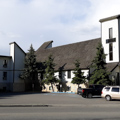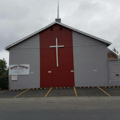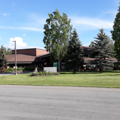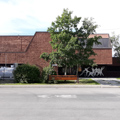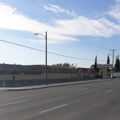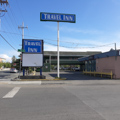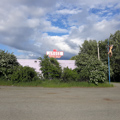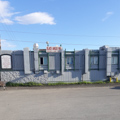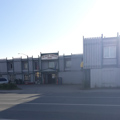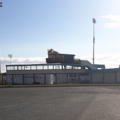Before the establishment of Anchorage in 1915, what is today the neighborhood of Fairview was a marshy region in the greater Dena’ina Athabascan ancestral homelands that white settlers referred to as Eastchester. During the first half of the twentieth century, this area remained sparsely populated and contained a few scattered cabins, primarily hewn from nearby spruce and birch trees. However, it would become Alaska's largest Black community and a center of entertainment during the immediate postwar decades.
Established immediately east and south of the original Anchorage townsite (now Anchorage's downtown commercial district) with natural borders of Ship and Chester creeks, to the north and south, respectively, Eastchester took its name from the nearby eastern fork of Chester Creek. Before World War II, a small population of African Americans lived in Anchorage, most of whom encountered racism and strict limitations as to where they could reside. When Black entrepreneur Zelmer Lawrence arrived in Anchorage in 1940, he recorded only eight to twelve other Black individuals. Lawrence and his wife were the only Black couple. As the city rapidly grew during the 1940s and 1950s, mostly as a result of the expansion of the U.S. military, word spread that well-paid and abundant jobs could be found in the territory. Black arrivals in Anchorage participated in the twentieth-century Great Migration, the mass movement of Black individuals from the Jim Crow South to the north and west.
But like many other American cities, Anchorage had a legacy of housing discrimination and racial exclusion, which included restrictive housing covenants and “whites only” classifieds. The Black men and women who thus arrived in Alaska often continued to encounter the racism from which they fled. While restrictive covenants were common throughout most of Anchorage, Eastchester remained one of the few communities that permitted Black people to own or rent a property. In particular, the southernmost portion of Eastchester, a swampy stretch between the bluffs and Chester Creek known as Eastchester Flats, became a central destination for Anchorage’s Black settlers. In 1952, the Anchorage NAACP chapter estimated that three-quarters of the city’s Black population lived in Eastchester Flats.
The Flats, as it was commonly known, hosted an assortment of huts and tar-papered houses, the majority of which were built as temporary and makeshift structures. Throughout Anchorage, building materials were in short supply and expensive. In addition, banks repeatedly denied Flats residents loans for proper home construction and improvement, yet another reflection of the era's racial discrimination. One resident recalled, “We lived in a shack about 10 by 10 [feet]. No lights, no indoor bathroom. We had to pump the water from the well. The houses had coal stoves, just a makeshift thing.” Most of the structures in the area were built from salvaged material, repurposed from the area’s military installations. This included corrugated metal Quonset buildings and improvised wood and concrete structures. The Flats lacked conventional zoning laws and building regulations, developing as it did beyond the city limits of Anchorage and thus not subject to local governance. One found a mix of commercial and residential properties and often commercial properties that doubled as living quarters for transient workers and others who may have been down on their luck or unable to find lodging elsewhere in the expanding town. After Anchorage absorbed the Flats into its city limits, a 1963 study found that only two structures met the municipal building codes with the rest “unfit for continued occupancy.”
Despite the role that discrimination played in shaping its demographics, the Flats was also a Black-created space that facilitated a sense of community. Black-owned businesses thrived in the neighborhood, including real estate offices, launderers, a beauty parlor, hotel, cafes, and barbershops. Although the area was primarily inhabited by Black people and transient workers who came through Alaska for one reason or another, the businesses of Eastchester Flats catered to a diverse crowd looking to blow off steam in a part of town generally free from law enforcement. In fact, throughout the 1950s the Flats was not technically within the boundaries of Anchorage and thus existed beyond the jurisdiction of its police department. “It was no police” in the Flats, recalled Joe Jackson, who documented the freewheeling nature of the community.
The makeshift clubs and lounges served liquor and beer; some contained small dining rooms equipped with modest kitchens to serve food. The North Starlight Lounge, a small concrete structure, poorly insulated but popular among many who lived in the community, served liquor from 8 a.m. until 5 a.m. Between 5 and 8 a.m., the small lounge served breakfast. Other clubs included the Backstreet Club, the Red Hut, and several short-lived businesses; many of these were illicit, but others were straightforward bars or restaurants. The Flats came to be viewed as a “colored quarter organized by and for colored people,” according to Herbert Frisby, a Black journalist who spent significant time in Alaska. “We were a small city within our own selves,” reflected Jackson, a resident through the 1950s.
Bar owner Zelmer Lawrence recalled: “You could go to the Flats and find things you couldn’t find any other place in the state. …At one time there were any number of cocktail bars running full blast in the Flats, you could get Schenley’s [a Canadian whisky], you could get the finest vodkas and wines and everything, no liquor licenses. There must have been twenty to thirty of them. Just a no-man’s land.” According to Jackson, “It was shacks all over the place, and it was prostitution and gambling, and everyone that was down there had some kind of a what they call a club.”
Fred Johnson, who came to Alaska as a service member in the U.S. military, recalled serving drinks at the North Starlight Lounge. Though the building was poorly constructed and composed of salvaged material, the goal was to provide a space for people to have a good time and leave one’s troubles behind. In this regard, these businesses were similar to the famous juke joints of the American South. Dancing and live performances livened up the lounge; notable acts included bluesmen like T-Bone Walker and Jimmy Rushing, as well as the performance artist LaWanda Page.
Jackson relayed a conversation with Anchorage’s chief of police who estimated the illicit businesses in Eastchester Flats brought in over $3 million throughout the 1950s. Ben Humphries, a longtime labor and civil rights activist, remembered the scene in similar terms: “But there were a lot of clubs, where, if you wanted to find the real action, you went to…Eastchester Flats...there was more fun there than you find anywhere else. Action happened there.”
Yet, by the late 1960s, the Flats was targeted for demolition as part of Anchorage’s so-called urban renewal. Though many of the building structures were ramshackle and identified as “blight,” they nonetheless composed a dynamic community within the Anchorage bowl. Hosting Alaska’s only concentration of Black-owned businesses, the loss of Eastchester Flats marked a turning point in the history of Anchorage. Today, what remains of the Flats is a low-to-middle income residential neighborhood. A mix of single-family detached residences and town houses typify the housing stock that has been constructed since the 1970s. Shiloh Missionary Baptist Church remains in the community and has long been the largest Black church in Alaska. The Anchorage Senior Center, an activity and recreational center for Anchorage's senior residents, occupies the largest single lot in what used to be the Flats. The Carrs grocery store, a site of the successful 1962 protest, remains open.
Since the redevelopment of Eastchester Flats, other districts, like Spenard, have emerged as notorious night spots. But they lack the diversity and buzz of the Flats. From southern cooking to northern juke joints, the Flats was a center of activity for several years in Anchorage’s postwar era. Although much of the community is now gone, its largely untold history reveals the complexities that underlie housing and hospitality in Anchorage today.
References
Agnew::Beck Consulting. Fairview Neighborhood Plan. Anchorage: Fairview Community Council, 2014.
Ball, Charles. Marketability Analysis Eastchester Urban Renewal Project Alaska UR-16. Spenard, AK: Economic Research and Planning Associates, 1963.
BGES, Inc. Fairview Neighborhood Historical Building Survey. Anchorage: Municipality of Anchorage, March 2008.
“Eastchester Renamed Fairview.” Anchorage Daily Times, September 17, 1954, 1, 11.
“Fairview Turning into Multi-Family.” Anchorage Times, January 22, 1978, 18.
Farrell, Chad R. “The Anchorage Mosaic: Racial and Ethnic Diversity in the Urban North.” In Imagining Anchorage: The Making of America’s Northernmost Metropolis, edited by James K. Barnett and Ian C. Hartman, 374-391. Fairbanks: University of Alaska Press, 2019.
Gillette, Helen. “The ‘Flats Has Outgrown Its Blueberry Swamp.” Anchorage Times, January 22, 1979, C5.
Hartman, Ian C., and David Reamer. “‘A Far North Dixie Land’: Black Settlement, Discrimination, and Resistance in Urban Alaska.” Western Historical Quarterly 51, no 1 (2020): 29-48.
Hartman, Ian C., and Fred Johnson, "'Basic and Primal:' Remembering the Food, Drink, and Revelry of Eastchester Flats." Edible Alaska (November, 2020).
Hunter, Don. “Cursed and Praised, ASHA is Part of Fairview.” Anchorage Times, January 22, 1978, C5.
Jackson, Joe. Interviewed by Bruce Melzer, c. 1982-1983. Bruce Melzer Oral History Interviews, Archives and Special Collections, Consortium Library, University of Alaska Anchorage.
Lawrence, Zelmer. Interviewed by Bruce Melzer, c. 1982-1983. Bruce Melzer Oral History Interviews, Archives and Special Collections, Consortium Library, University of Alaska Anchorage.
“People Are Talking About.” Jet, April 29, 1964, 140-142.
Reamer, David, with Clare Dannenberg. An Oral and Written History of Fairview: Past, Present, & Future. Anchorage: Center for Community Engagement & Learning, University of Alaska Anchorage, 2015.
Urban Renewal Plan Eastchester Area Project Alaska R-16 Anchorage, Alaska. Anchorage: Alaska State Housing Authority, 1965.
Wangsness, Paul H. A History of the Unification of the City of Anchorage and the Greater Anchorage Area Borough. Anchorage: Anchorage Urban Observatory, 1977.
Writing Credits
If SAH Archipedia has been useful to you, please consider supporting it.
SAH Archipedia tells the story of the United States through its buildings, landscapes, and cities. This freely available resource empowers the public with authoritative knowledge that deepens their understanding and appreciation of the built environment. But the Society of Architectural Historians, which created SAH Archipedia with University of Virginia Press, needs your support to maintain the high-caliber research, writing, photography, cartography, editing, design, and programming that make SAH Archipedia a trusted online resource available to all who value the history of place, heritage tourism, and learning.

